Nationalist Approaches to Histories of the Slavs and the Balkans
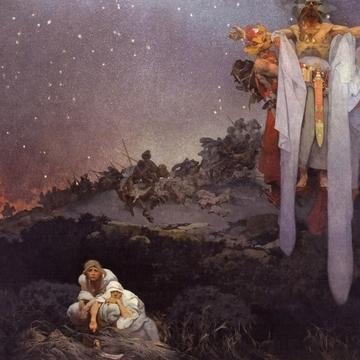
Mucha (1912), The Slav Epic Cycle, No. 1
The Slavs in their original homeland
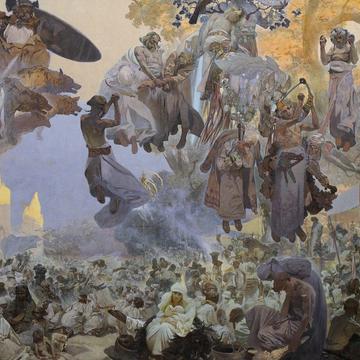
Mucha (1912), The Slav Epic Cycle, No. 2
The Celebration of Svantovit
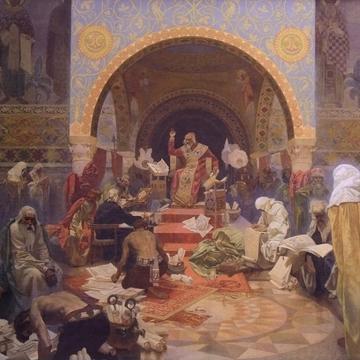
Mucha (1914), The Slav Epic Cycle, No. 4
Tsar Simeon I of Bulgaria
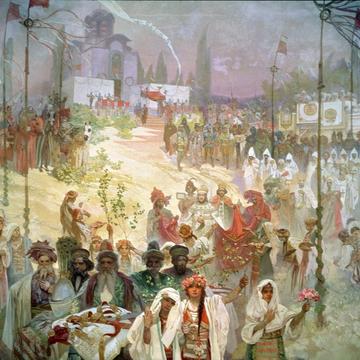
Mucha (1926), The Slav Epic Cycle, No. 6
The Coronation of the Serbian Tsar Stefan Dusan
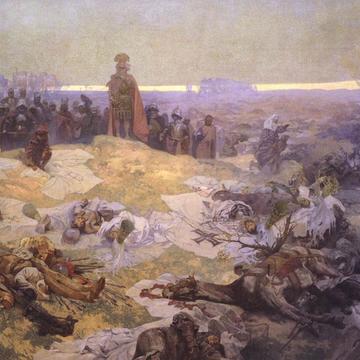
Mucha (1924), The Slav Epic Cycle, No. 10
After the Battle of Grunewald
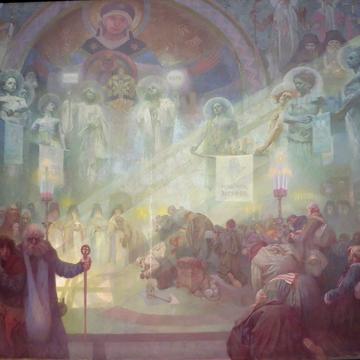
Mucha (1926), The Slav Epic Cycle, No. 17
The Holy Mount Athos
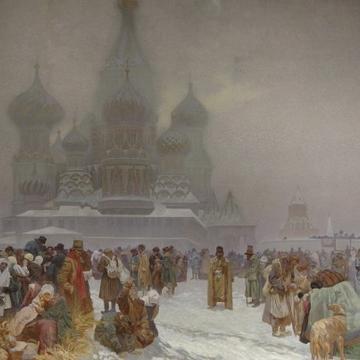
Mucha (1914), The Slav Epic Cycle, No. 19
The Abolition of the Serfs in Russia
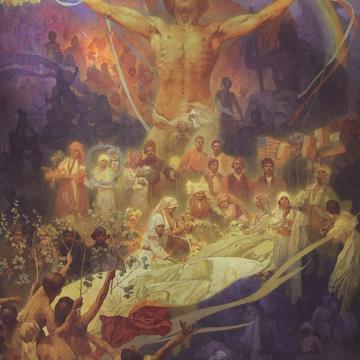
Mucha (1926), The Slav Epic Cycle, No. 20
The Apotheosis of the Slavs. Slavs for Humanity
The images presented here are a selection from Alphons Mucha’s Slav Epic, a cycle of twenty paintings produced from 1912 to 1926 and destined to be a celebration of the history of the Slavic peoples from the time of their mythic origins to the period following the Allied victory after the First World War (note that: Central Europe and the Eastern Balkans are largely represented, while the Western Balkans are not really mentioned and the northern Slavic lands are scarcely mentioned). For obvious reasons, neither the Nazis nor the Communist regime of Czechoslovakia appreciated this oeuvre that elevated the Slavs using a visual language that idealized monarchy, religion, and the mythical Slavic People. Furthermore, the visually-translated topics focussed largely on military victories against western groups (mainly the Germanic peoples) throughout history, employing a high-fantasy symbolic landscape that borrowed from the Greco-Roman world, from Slavic folk dress (largely from the Ottoman period and shared by the whole of the Eastern Mediterranean), and from Church culture (particularly for the medieval scenes). To this end, Mucha applied a regime of knowledge that had been crafted about the ‘Slavic peoples’ based on academic writings, from philology to ethnography and folk culture, which he studied during his travels around the ‘Slavic world’. The circumscribed ideological landscape of the cycle reflects several key points, namely: the Slavs are a European people and this cycle shows their contribution to European history at key moments over the past centuries; the various Slavic peoples have a distinct national character and history, and one that is separate from and has often been opposed to Germanic peoples; and the Slavs are (or should be) a unified people due to their ethnic, linguistic, and cultural heritage.
Indeed, we have to understand this cycle of paintings within the context of the events leading up to the First World War and the struggle for emancipation from the Austro-Hungarian Empire, as well as the push for national recognition, and the formation of Slavic nation-states, especially following the victory of the Allies. If we review the various speeches made by the proponents of western Allied powers, such as Great Britain or France, to bolster their allies in the Balkans, there is a constant assurance of the possibility of ‘self-determination’, ‘unification’, ‘independence’, and territorial gain via ethnic ‘re-grouping’ should the Allies win. It is necessary to understand these promises and proclamations against the historical reality of a region known as the Balkans that is/was ethnically, religiously, and linguistically mixed, and that had once been part of a larger politico-territorial entity, the Ottoman Empire. It ought to be noted that the Ottoman Empire had been the target of anticolonial initiatives, such as the promotion of nationalisms, by European imperial powers seeking to break up its vast territory. The 1878 Congress of Berlin saw the independence of several Balkan states, but it was the Greek War of Independence of the 1820s that had really stimulated European intervention by capturing the imagination of European intellectuals. While Greece already held a special, mythic place as the ‘childhood’ of Europe and the origin of European thought and institutions,[1] the wider Balkans developed their own narratives of ethnogenesis and cultural identity.
The best way to understand the forces at play in constructing ‘regimes of knowledge’ about the Slavs/Balkans is to revisit several points of historiography and, most importantly, the intellectual movements that gave rise to ‘the Slavs’ and to ‘Slavic History/Studies’. For example the ‘regime of knowledge’ that best describes Mucha’s oeuvre is that which developed out of the Pan-Slavic Movement, a romantic-nationalist movement that encouraged the discovery (or invention) of a shared Slavic identity and history based on the study of history (really ethnography), philology, and folklore. From the outset, the movement had several obvious political objectives, one of which was the emancipation of the Southern Slavs from the Ottoman Empire and the Hapsburg/Austro-Hungarian Empire. To this end, a ‘regime of knowledge’ was constructed to assist in this endeavour and to articulate the parameters of who was being liberated and on what basis. A key event of this movement was the First Pan-Slavic Congress that took place in Prague in 1848, presided by the ‘Austroslav’ František Palacký and attended by such prominent academic figures as the philologist Pavel Jozef Šafárik (whose works, compiling and editing medieval Slavonic sources from Central and South-eastern Europe, are still used today). From the beginning, the intellectual basis for the congress featured an insistence on the unity of the Slavic peoples and their shared history, proven by the existence and pointed compilation of historical sources from the medieval and early-modern period. The resulting Manifesto to the Nations of Europe insisted on the shared identity of the Slavic peoples who would “extend a brotherly hand” to “neighbouring nations” who would recognize and help with the effort of gaining distinction within the Austro-Hungarian Empire (in anticipation of possible Russian supremacy should the Austro-Hungarian Empire break up). The congress was quickly disbanded by the Austro-Hungarian authority and martial law was declared.
It should be noted that there are many ways in which pan-Slavism manifested itself from the outset:
- A more radical wing that wanted to unite with workers’ and socialist movements;
- Austroslavism (amongst the Croats and Slovenes and in Central Europe) that aimed for distinction within the Austro-Hungarian imperial framework;
- Slavic nationalism under a monarchy, such as that of the Serbian Kingdom proposed by the Association of Serbian Philology under the auspices of which philologists sought an ‘ethnically pure’ Slavic land and people, which they justified via medieval Slavonic sources.
Thus, pan-Slavism manifested itself in different ways throughout the Slavic-speaking world, but we should note that it was also intimately linked (in terms of methods and ideology) with wider European manifestations of romantic-nationalism, or ethno-nationalism. Academic disciplines bolstered this movement from the beginning, with archaeology playing a key role, especially the 19th archaeological findings of the Polish School. The ideological positioning of pan-Slavism and the search for a common culture of the Slavs relied heavily on medieval textual sources, many of which barely dealt with questions of ethnicity beyond practicality, i.e. using language, religious affiliation, and often military practices to distinguish between groups.
The earliest manifestation of pan-Slavism came in the form of Slavophilism, which developed first in Russia during the 18th century following debates about the origins of the Russian people. The early historiography on the emergence of Russia reflects a narrow set of assumptions about ethnicity and cultural supremacy represented by the Normanist/Anti-Normanist theories. The autumn of 1749 and the spring of 1750 witnessed the first and very long academic debate on the history of Rus/Russia during the 21 sessions of the Conference of the Imperial Academy of Sciences: polemics dealt with the role played by the Varangians (Northmen/Norsemen or Vikings) in the early history of Rus, and focussed on the origins of the name ‘Russia’ and its state formation. This debate had been provoked by the official historiographer of the Imperial Academy of Sciences, Gerhard Friedrich Müller, who presented a talk based on his dissertation Origines gentis et nominis Russorum.[2] The permanent secretary of the academy J. D. Schumacher found certain elements of the dissertation prejudicial to Russia and the text was sent for appraisal by members of the Academy, such as Mikhail Lomonosov and Vasilii Trediakovsky. Müller was accused of denigrating Russia and its people by denying their ancient origins. His assertion that the Varangians, who feature in the Primary Chronicle,[3] were originally Scandinavians caused great offence and Müller’s dissertation was banned, he was demoted in academic rank, and his salary was halved.
So, what was so harmful to ‘the Russian people’ in Müller’s dissertation? In his thesis, Müller presented the main elements of what came to be known as the Norman Theory (Norman meaning Scandinavian in this case). He claimed that the Slavs had not settled the Dnipro region until the reign of the Byzantine emperor Justinian and that the Rus rulers were of Scandinavian origin (from Norway) and had conquered the Slavs. However, given the political context of the reign of Empress Elizabeth, the war between Russian and Sweden in 1741-2, and the previous Northern War of the early 18th century, Russian elites found it insupportable that they had been conquered and colonized by Scandinavians. The Russian polymath and academician, Mikhail Lomonosov, presented an alternative view of the origins of Rus, within a Russian framework. He used the Synopsis, a 17th century Muscovite chronicle that put forth the idea that the Varangians were Slavs. Lomonosov claimed that the name ‘Slav’ derived from the word ‘glory’ (slava) and traced their settlement on the Dnipro long before the reign of the emperor Justinian. Lomonosov’s views caused a shift in Russian historiography by changing the terms of the debate: it was embraced by some – especially by the later, 19th century Slavophiles who formed literary circles (Turgenev); artists (such as the Peredvizhniki); but it was rejected by others. The court elite appeared to favour a more cosmopolitan Rus (rather than a purely Slavic Rus), such as that described by the 18th century historian Vasilii Tatishchev who insisted on the multi-ethnic character for early Rus. But, the pure Slavic (or ethnically Slavic) identity of Rus found its clearest articulation in popular writings, visual culture, and amongst early socialist activists. The articulation of Slavic nationalism and racialized hierarchies positing different stages of development between Russia (meaning the continental European parts of Russia, Ukraine, and Belarus) and the steppe (meaning Eurasia) was undertaken by the 19th century historian Sergey Solovyov.
Thus, we see the role of the Academy in the invention of identity (national and ethnic) and the Russian example is one that would be repeated, especially in the 19th century and early 20th century in the Balkans.[4] Everywhere, philology, ethnography (history), and archaeology would be employed to create regimes of knowledge that justified, scientifically, the reality of ‘ethnic identity’. The various outputs of these fields eventually translated to a political programme that would gain supremacy after World War I, that of the nation-state based on the principle of “…nationalism and its equation with particular ethnic groups… [resulting in] the practice of dividing and engineering the populations of whole countries, extending the principle of eugenics to that of nations.”[5] Of course it would be easy to designate the production of knowledge in the past as not objective and full of cultural and political prejudice, but the scholarly works produced by many of the figures mentioned above continue to be useful handbooks and historiographic works. However, these works, the historical processes outlined above, and the regimes of knowledge continue to bear upon how we view the Balkans or articulate information about ‘the Slavs’ in contemporary historiography. The various trajectories of knowledge production are necessary factors in identifying received ideas and discursive patterns (both their content and short-hand, e.g. ‘the Slavs’). For scholars of Byzantine Studies, the implication of the long history of how sources were compiled, studied, and utilized is a necessary step in understanding everything from the objects of study to the very vocabulary of the field.
Alexandra Vukovich
St Edmund Hall
[1] Frederick Rosen, Bentham, Byron and Greece. Constitutionalism, Nationalism, and Early Liberal Political Thought (Oxford: Clarendon Press, 1992); Nadia Urbinati, Mill on Democracy. Rome the Athenian Polis to Representative Government (Chicago and London: University of Chicago Press, 2002). The European intervention and involvement of high-profile actors (such as Byron) in the Greek War of Independence was the political translation of an intellectual programme that can be traced to the 18th century when ‘philosophic historians’, such as Edward Gibbon, sought to examine the significance of historical events and their implication for contemporary concerns (patterns of progress, decline, etc.). As a result, certain periods (Gibbon’s ‘happy periods’) of Classical Antiquity and certain Greek and Roman political institutions were posited as models of state and citizenship.
[2] The development of ethnography and the attendant ‘race science’ in the Russian Empire remains to be fully studied. The study of ethnography arose in Russia out of its eastward expansion into Siberia and beyond, during which a Volker Beschreibung was commissioned. The description of Siberia’s ‘peoples and languages’ by D. G. Messerschmidt following the First Kamchatka Expedition of 1724-30 was a first step in mapping the peoples of the empire and articulating difference. It was when the largely German and Prussian scholars hired by the Imperial Academy of Sciences began exploring the ethnogenesis of western Russians (implicating the elite) that the methods of state enterprise of ethnography were questioned. See: Han Vermeulin, Before Boas: The Genesis of Ethnography and Ethnology in the German Enlightenment (Lincoln: University of Nebraska Press, 2015); for studies of imperial Russian views on race and ethnicity, see the works of Nathaniel Knight (Seton Hall University).
[3] The Povest vremennykh let (Primary Chronicle) is one of the compiled chronicles of Rus that cover the history of the pre-Mongol period and beyond. Müller was a key figure in the development of the study of chronicles as historical and ethnographic sources, as well as chronicle textology, i.e. how the chronicles were written/edited/compiled.
[4] See: Stefan Detchev, “Who are the Bulgarians?” for an illustration of the coexistence of disparate strands of historico-political thought within an academy and the promotion of certain discourses to the exclusion of others.
[5] Robert J. C. Young, Empire, Colony, Postcolony (Chichester: Wiley, 2015), 110. Young further outlines the population transfers in the Balkans and the attendant violence of sending people “back”, to create an “ethnically homogenous” nation-state.
New Critical Approaches to the Byzantine World Network, TORCH Networks



